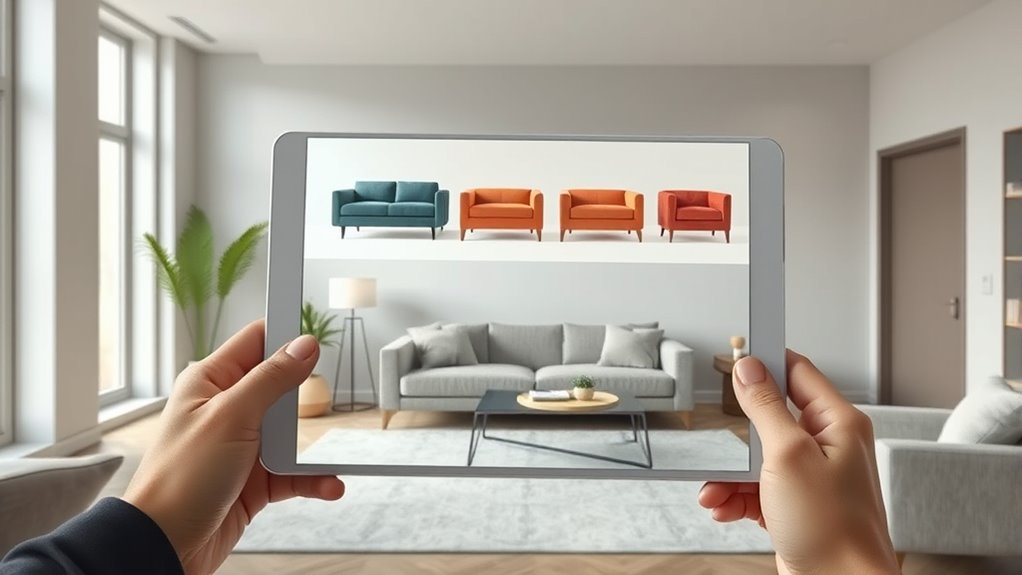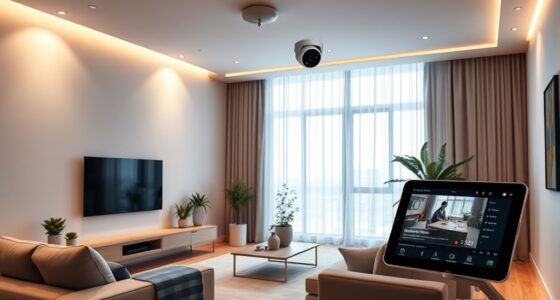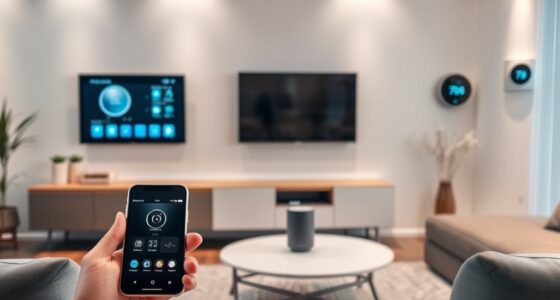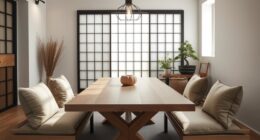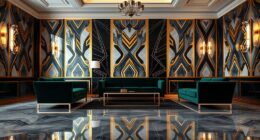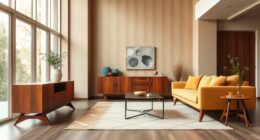To integrate AR for virtual room makeovers, choose user-friendly AR tools that work with your design software and support real-time customization. Prepare your space by cleaning and ensuring good lighting for accurate surface detection. Use your device’s sensors and spatial mapping features to scan your room from multiple angles. Incorporate interactive elements like furniture resizing and client annotations to create engaging experiences. Continue exploring to learn how these steps can help you achieve realistic and confident virtual redesigns.
Key Takeaways
- Select compatible AR tools that integrate seamlessly with your existing interior design software for real-time visualization.
- Prepare the physical environment by clearing clutter, ensuring good lighting, and stabilizing devices for accurate AR overlay.
- Use advanced sensors like LiDAR or structured light to capture precise room dimensions and enable accurate virtual object placement.
- Customize virtual elements in real-time, utilizing extensive 3D material libraries and client feedback to tailor the design.
- Enable collaborative AR sessions allowing clients to interact, suggest adjustments, and participate actively in the room makeover process.
Understanding the Basics of Augmented Reality in Room Makeovers
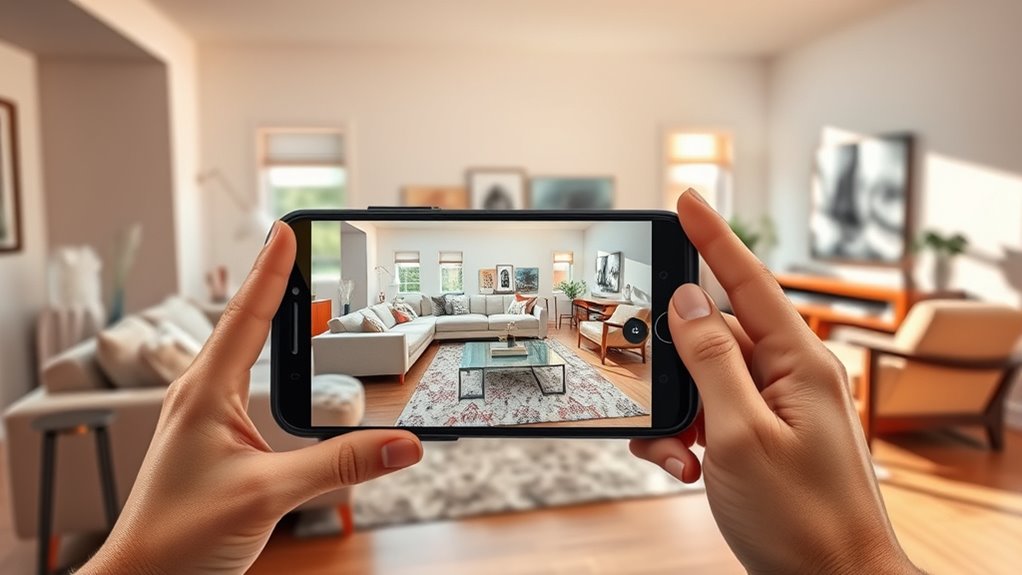
Augmented Reality (AR) transforms how you redesign your space by overlaying digital furniture, decor, and layouts directly onto your real environment through your smartphone or AR glasses. This technology enables virtual visualization, allowing you to see how different interior design ideas will look without moving a single piece. AR tools use device cameras, sensors, and advanced spatial mapping to accurately place and scale virtual objects within your space in real-time. When you’re exploring room makeovers, AR makes it easy to modify colors, textures, and arrangements instantly, giving you a clear preview of your design choices. By capturing your room’s dimensions and environment, AR creates realistic previews, helping you make confident, informed decisions while reducing costly reconfigurations. Additionally, understanding the rustic farmhouse aesthetic can help you better visualize how specific elements like vintage furniture or cozy textiles will integrate into your space. Incorporating predictive modeling insights can further enhance your planning process by suggesting design options based on your preferences and existing room data. Moreover, the contrast ratio of your display can significantly influence how well you perceive color and detail in AR visualizations, ensuring more accurate representations of your design ideas. For optimal results, being aware of the color accuracy of your device can improve how faithfully your virtual designs translate to real-world appearances.
Selecting the Right AR Tools and Software for Your Projects
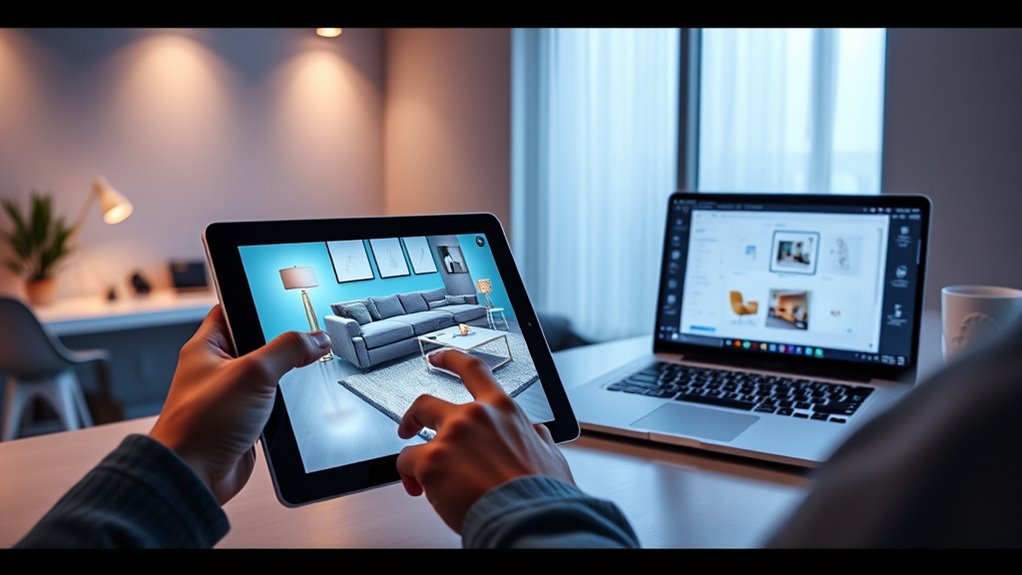
Choosing the right AR tools and software is essential to streamlining your virtual room makeover projects. Look for AR tools that seamlessly integrate with your existing design software, like Foyr Neo, which supports 3D models and real-time editing. Prioritize applications that offer high-resolution visualization and photorealistic textures to create realistic virtual remodels. Select platforms with user-friendly interfaces, ensuring quick adoption by both you and your clients. Compatibility across multiple devices—mobile phones, tablets, and desktops—enhances flexibility for on-site and remote work. Also, consider tools that facilitate collaboration, virtual furniture placement, and multi-platform access. These features boost project efficiency, improve client engagement, and make your virtual room makeovers more effective and professional. Additionally, choosing AR solutions that incorporate Prairie Scenery can provide inspiration for more natural and authentic design backgrounds. Incorporating sound healing science principles into your virtual environments can subtly enhance client relaxation and satisfaction during the design process. For an even more immersive experience, select AR platforms that include butter history insights, adding a unique cultural dimension to your design presentations. Moreover, exploring beauty store hours can help you plan your client meetings and project timelines effectively. To further enhance your virtual environments, consider anime-inspired textures and themes that resonate with diverse client preferences and add a creative touch.
Preparing Your Space for Accurate AR Visualization
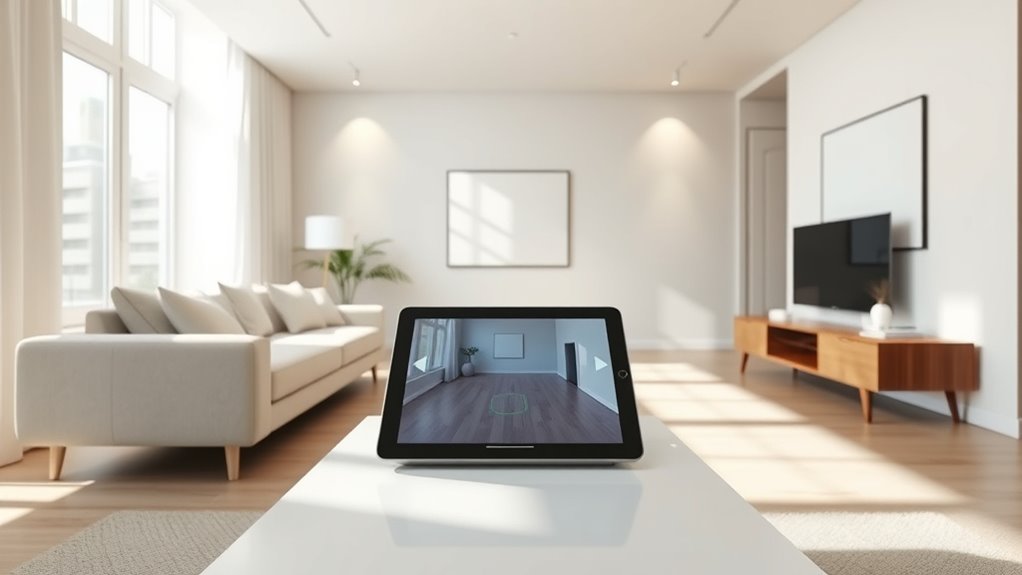
To get the best AR results, start by clearing the surface where you’ll place virtual objects to avoid distortions. Make sure your space is well-lit with consistent lighting so the AR system can track movement accurately. Additionally, consider the indoor aesthetics of your space, such as matching planters and decor, to enhance the overall visual experience. Incorporating attention during setup can significantly improve the accuracy of your virtual room makeover. Ensuring your devices are stabilized and positioned properly, such as on a flat surface or at an optimal angle, can help achieve smooth, precise visualization. Also, spatial awareness is crucial for seamless integration of virtual elements within your environment. Properly understanding lighting conditions can further enhance the effectiveness of AR visualization.
Clear Surface Preparation
Ensuring your space is clean and free of clutter is essential for accurate AR visualization. Start by cleaning surfaces and removing unnecessary items to provide a clear view for the AR device. Proper lighting, whether natural or artificial, helps with surface detection and tracking. Calibrate your device’s sensors and camera settings before starting, ensuring the AR system aligns properly with your room. Use flat, stable surfaces for placing furniture or virtual objects, and avoid reflective or glossy materials that can disrupt tracking. Mark or identify reference points such as corners or distinctive features to improve calibration and stabilize overlays. Incorporating automation technology can also help streamline setup processes and optimize AR performance. Additionally, understanding emotional support can help users stay patient and motivated during the setup process, especially if encountering technical challenges. A thorough understanding of surface detection can significantly enhance the accuracy of virtual overlays. Recognizing how user interaction influences AR accuracy can help tailor the experience to individual preferences. Proper surface preparation is crucial because it directly influences the performance tuning ability of the AR system to function smoothly and reliably. Clear surface preparation guarantees AR can accurately detect surfaces and track movements, resulting in seamless virtual room makeovers.
Adequate Lighting Conditions
Have you considered how lighting impacts the accuracy of your AR room makeover? Proper lighting is essential for ideal AR visualization, as it directly affects how virtual objects are placed and rendered. Bright, consistent illumination helps improve camera quality and AR accuracy, ensuring virtual elements look realistic. Avoid harsh shadows or uneven lighting, as they can distort overlays and reduce detail accuracy. Turn on all relevant lights before scanning your space to maximize ambient light levels, which enhances environment conditions for better detection. Additionally, keep your device’s camera lenses clean to prevent dirt or smudges from obstructing light entry and impairing AR detection. Good lighting conditions are crucial for accurate virtual object placement and a seamless AR experience.
Proper Device Placement
Proper device placement is key to achieving accurate AR visualizations. To enhance environment detection, keep your device’s camera and sensors unobstructed and clean. Clear your space of clutter and move objects that could interfere with spatial mapping. Use a flat surface and ensure the area is well-lit, which helps the device scan accurately and place virtual objects precisely. Position your device at a consistent height and distance from the floor to maintain stable overlays. Follow your device manufacturer’s guidelines for sensor calibration to improve placement accuracy. Proper device placement ensures stable overlays, reduces errors in spatial mapping, and enhances the overall AR experience. When your environment is optimized, virtual room makeovers appear more realistic and seamless.
Capturing the Environment: Techniques for Effective Spatial Mapping
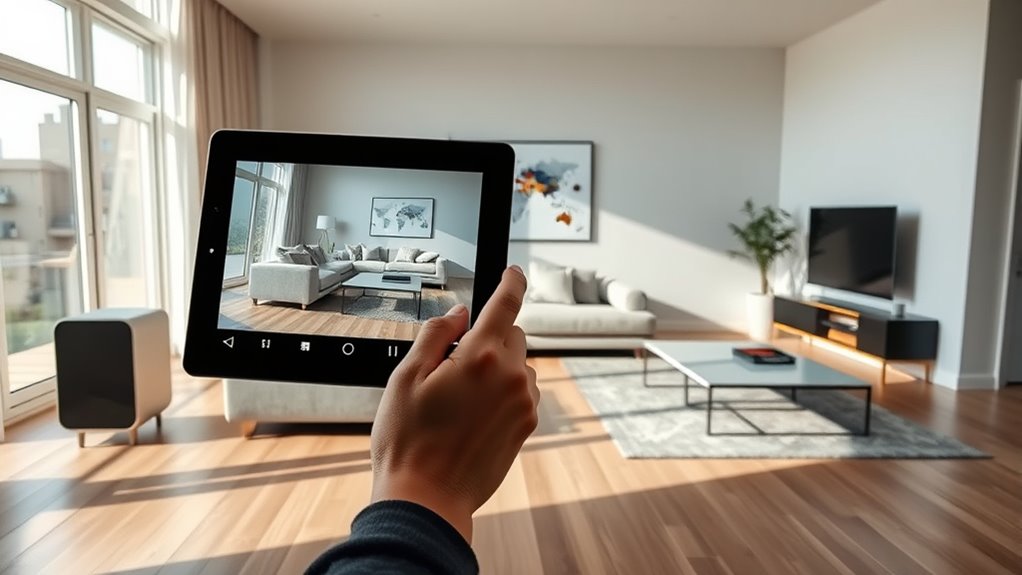
To get the best virtual room makeover, you need to capture your space accurately. Use your device’s depth sensors or LiDAR to measure room dimensions precisely, and guarantee your lighting is consistent for clear images. Taking multiple scans from different angles helps create a detailed map that handles irregular layouts and obstacles effectively.
Precise Depth Sensing
Accurate depth sensing is essential for creating realistic virtual room makeovers, and advanced sensors like LiDAR, structured light, or time-of-flight cameras make this possible. These sensors capture detailed environmental data, enabling precise spatial mapping. To optimize results, consider these key points:
- High-resolution depth data enhances environmental accuracy.
- Sensor fusion combines inputs from multiple sensors for better spatial understanding.
- Point clouds generated by depth sensors form the basis of detailed 3D models.
- Calibration aligns depth data with visual imagery, ensuring virtual objects match real-world dimensions.
Accurate Surface Detection
Advanced sensor technologies like LiDAR, structured light, and time-of-flight cameras are essential for precise surface detection in AR, as they map room geometry with high accuracy. These sensor technologies gather detailed data for effective surface detection and enable robust spatial mapping. Algorithms such as plane detection and depth estimation analyze this sensor data to identify horizontal and vertical surfaces, allowing virtual objects to anchor realistically. SLAM (Simultaneous Localization and Mapping) continuously updates the environmental model as you move, ensuring accurate virtual placement. Proper calibration, whether marker-based or markerless, enhances surface detection accuracy by aligning virtual overlays with physical surfaces. Keep in mind that environmental factors like lighting, reflective surfaces, and clutter can impact sensor performance, requiring robust hardware and adaptive software algorithms for ideal results.
Optimized Lighting Conditions
Consistent lighting conditions are essential for capturing the environment effectively, as they help AR systems accurately interpret spatial features. To achieve this, use HDR lighting or multiple exposures to capture a wide range of lighting details, enhancing environment scanning accuracy. Conduct environment scans during times of diffuse ambient lighting—like overcast days or well-lit indoors—to minimize shadows and highlights that can distort spatial mapping. Incorporate real-time light estimation features in AR SDKs like ARKit or ARCore, which adapt virtual object placement to changing light. Additionally, proper environment calibration and controlling ambient lighting during capture reduce reflections and shadows, ensuring environment consistency. This careful approach leads to more precise virtual overlays that blend seamlessly with your real room.
Customizing Virtual Elements to Match Client Preferences
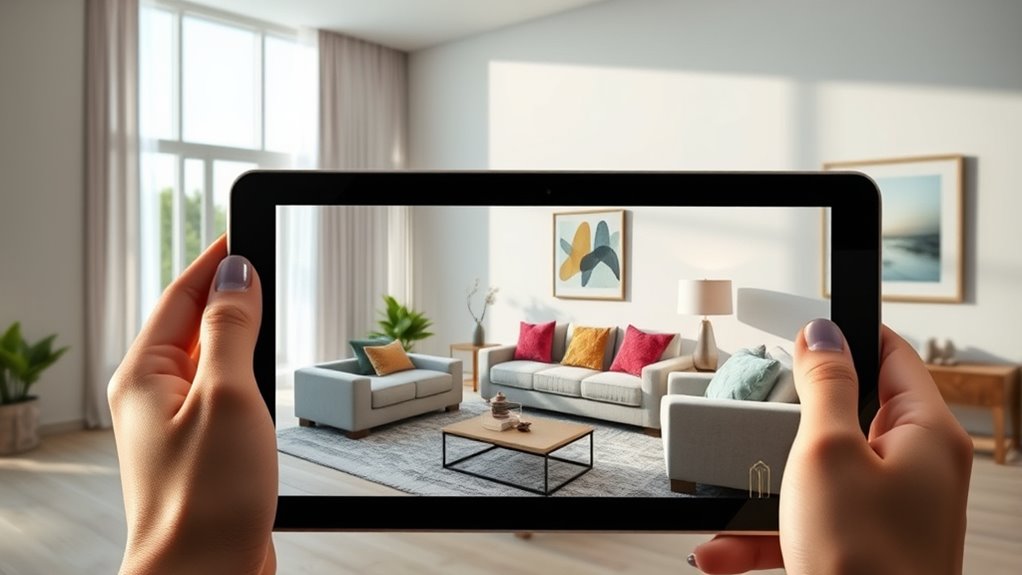
To effectively match virtual elements to your client’s preferences, you can leverage AR design tools that enable real-time adjustments of furniture, colors, and textures. Virtual customization allows you to modify finishes, fabrics, and decorative details instantly, guaranteeing the design reflects your client’s style. Use extensive 3D material libraries within AR platforms to access thousands of options for personalized design choices. Incorporate client feedback directly in the AR environment by making instant modifications, which helps you fine-tune the look and feel. Additionally, AR measurement overlays and scale controls ensure virtual pieces fit perfectly within the space, matching spatial and visual preferences. This seamless integration of AR features helps create a tailored, client-specific virtual makeover experience with precision and efficiency.
Implementing Interactive Features for Client Engagement
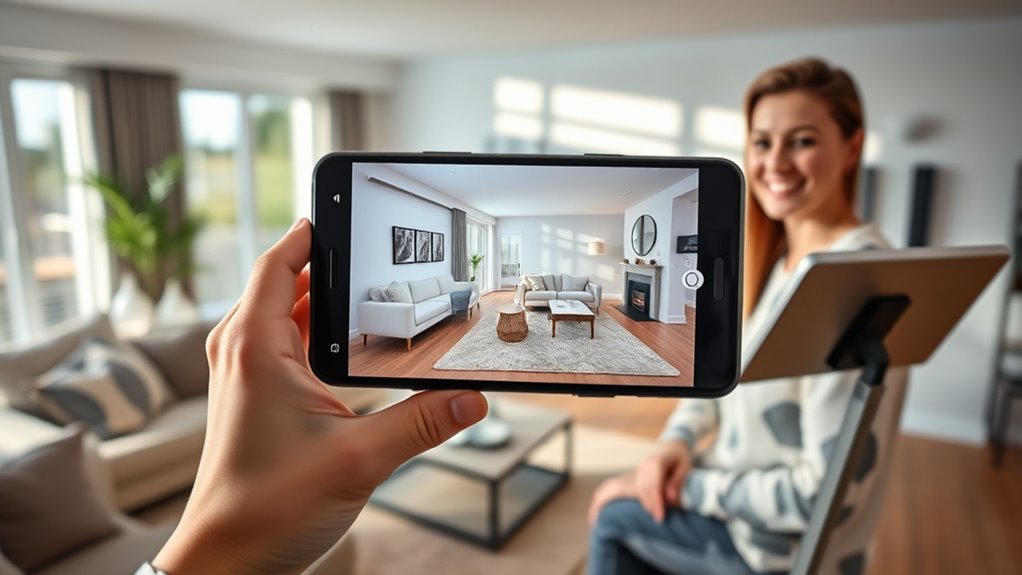
Building on the ability to customize virtual elements, integrating interactive features transforms client engagement by making the design process more dynamic and participatory. You can enhance the AR room experience with features like:
- Real-time furniture customization, allowing clients to modify pieces during virtual walkthroughs.
- Touch-based controls for resizing, repositioning, or swapping decor items directly within the AR environment.
- Annotation tools enabling clients to leave comments, suggest changes, or highlight concerns during reviews.
- Multi-user collaborative AR sessions where clients and designers work together, providing instant feedback.
These interactive features foster active participation, making the virtual makeover more engaging and personalized. By leveraging AR’s capabilities, you create a more immersive and client-centered design process that encourages exploration and collaboration.
Evaluating and Refining Your AR Makeover to Achieve Realistic Results
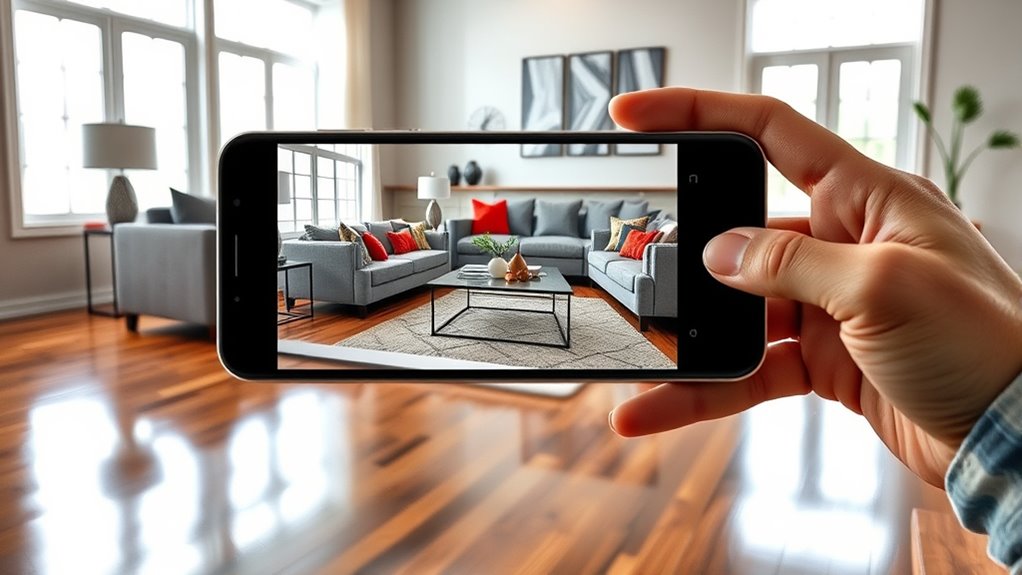
Achieving realistic results with your AR room makeover requires careful evaluation and ongoing refinement. Use high-resolution AR models to guarantee virtual elements blend seamlessly with your environment, boosting realism. Compare multiple design iterations side-by-side in AR to objectively assess furniture, colors, and layouts. Incorporate lighting simulations to see how natural and artificial light influence material and color appearance under different conditions. Gather stakeholder feedback during AR visualization to spot discrepancies and refine details accordingly. Regularly update and calibrate AR overlays based on actual room measurements and user input, improving accuracy. This process helps you identify issues early, refine your design, and create an authentic, immersive virtual makeover that truly reflects your vision.
Frequently Asked Questions
How Do You Integrate Augmented Reality?
To integrate augmented reality, you’ll need to include AR SDKs like ARKit or ARCore into your app. These tools help detect your environment and place virtual objects accurately. Develop a library of realistic 3D models, enable real-time surface tracking, and create intuitive controls for placing and customizing furniture. Make sure your app works smoothly across devices by optimizing performance and ensuring compatibility, so users enjoy a seamless AR experience.
How Does Augmented Reality Work With Interior Design?
Augmented reality in interior design lets you see digital furniture and decor overlaid onto your actual space through your device’s camera. It uses sensors and SDKs like ARKit or ARCore to understand your room’s dimensions, surfaces, and lighting. As you move around, AR tracks your environment, ensuring virtual objects stay aligned. This real-time visualization helps you experiment with styles and layouts before making any physical changes, making design decisions easier.
Is There an App Where I Can Take a Picture of My Room and Redesign It?
Imagine you’re in the 21st century, not the 1800s! Yes, there are apps like Houzz, Decor Matters, and IKEA Place that let you take a photo of your room and redesign it instantly. You can experiment with furniture, colors, and layouts using augmented reality. These tools help you visualize changes in real-time, save your favorites, and share them for feedback, making redecorating easier and more fun than ever.
Is There an AI That Can Design My Room?
You’re wondering if an AI can design your room. Yes, many AI-powered tools like Planner 5D, Modsy, and Houzz can generate room layouts and style ideas based on your preferences. You simply input your room details or preferences, and the AI creates customized designs, mockups, and decor suggestions. While these tools are powerful, you’ll still want to review and tweak the designs to match your personal taste and practicality.
Conclusion
By embracing AR for virtual room makeovers, you can transform how clients experience redesigns—making ideas come to life instantly. Many believe AR is just a flashy tool, but research shows it profoundly boosts client satisfaction and confidence. When you master AR integration, you’re not just visualizing spaces—you’re creating immersive, realistic experiences that lead to better decisions and stunning results. So, trust the technology; it’s reshaping interior design in ways you never imagined.
